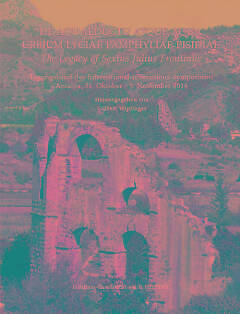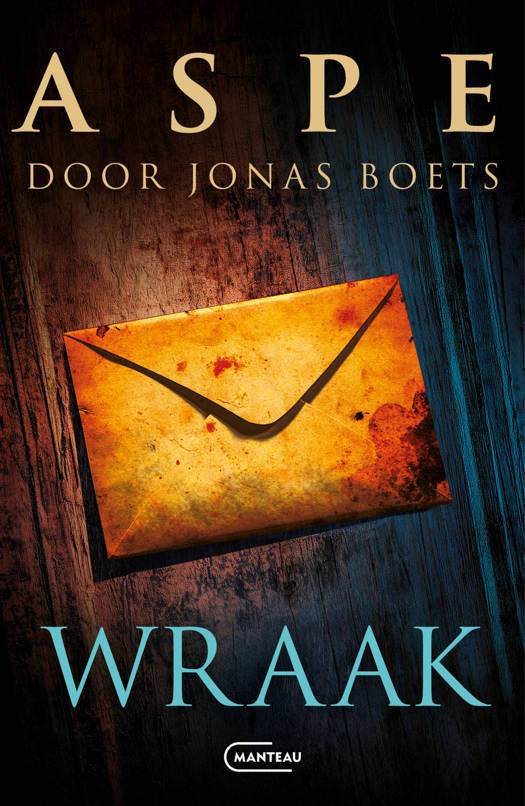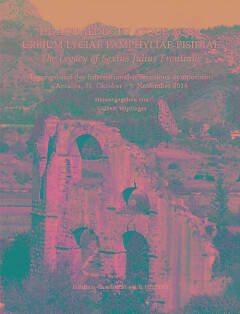
- Afhalen na 1 uur in een winkel met voorraad
- Gratis thuislevering in België vanaf € 30
- Ruim aanbod met 7 miljoen producten
- Afhalen na 1 uur in een winkel met voorraad
- Gratis thuislevering in België vanaf € 30
- Ruim aanbod met 7 miljoen producten
Zoeken
de Aquaeductu Atque Aqua Urbium Lyciae Pamphyliae Pisidiae / The Legacy of Sextus Julius Frontinus
€ 199,95
+ 399 punten
Omschrijving
English summary: This volume, edited by Gilbert Wiplinger, is already the third publication derived from the Frontinus Symposium as a BABESCH (The Society for Ancient Mediterranean Archeology) Supplemental Volume in the History of Water Management. Ever since the 2004 symposium "Cura Aquarum in Ephesus" (BABESCH Suppl. 21), the region around Antalya in Turkey had presented itself as a promising location for a future conference on account of the numerous, spectacular hydraulic structures found there. It was only at the end of the 2011 symposium, "Historical Aqueducts: Yesterday-Today-Tomorrow" (BABESCH Suppl. 24), however, that Prof. Havva Iskan-Isik of Akdeniz University in Antalya issued the invitation which finally helped to realize the goal of a conference in this historically important location. The title of the symposium, "De Aquaeductu atque aqua urbium Lyciae Pamphyliae Pisidiae- The Legacy of Sextus Julius Frontinus," was derived from the close connection between Antalya with the three ancient regions of Lycia, Pamphylia, and Pisidia and the intense, scholarly engagement with the work of Sextus Julius Frontinus titled "De aquaeductu urbis Romae" ("The Aqueducts of the City of Rome"), the most recent edition of which was published through the Frontinus-Geselleschaft in 2013. The thirty-one lectures presented in this anthology are associated in part with the excursion program that took place during the conference from October 31st to November 9th. The introductory lectures "Engineering in the Service of Archeology in the Example of the Water-Supply Conduits in Ephesus" and "Inscriptions from the Roman Water Pipes" are followed by several region-specific groups, with the first group concentrating on water supplies and urban water-supply systems in Anatolia. Antalya's water systems, as well as those connected to it in Side, Aspendos, Phaselis and Patara, were visited during the conference excursion. The studies in the next section deal with ancient water management systems in other regions of the Roman Empire (Alba Fucens in Italy, Cadiz in Spain). A further region-based section follows whose case-studies center on Jordan. Two further studies are concerned with ancient solutions to water-supply issues in arid and semi-arid regions using the examples of Petra and Gerasa. The next group of articles are organized according to non-regional themes. The first section deals with cisterns which could be studied in locations close to Antalya such as Patara and Termessos. The next articles are united in their focus on the architectural structures of Roman baths from different regions ranging from Italy (Baia) to Turkey (Patara) to Israel (Caesarea Maritima). This section includes an essay on the deaths of ancient rulers in baths. Two further offerings are concerns with rather varied themes: one deals with the private use of water in the eastern Mediterranean and the other investigates the religious use of water in Rome itself. The next thematic section presents studies concerned with hydraulic engineering. Theoretical problems of hydrology are raised as well as studies derived from local sites near Antalya. These studies range on subjects from the flood estimation methods on ancient water conduits in Bezirgan to the complicated siphon-system of Aspendos, to questions about the speed of water flow in Roman Nymphaea as well as water management in the ancient city of Sagalassos. The final theme is concerned with the industrial use of water, in which watermills in Palestine, mines in Span, and late-antique pipes in Ephesus are analyzed. The conclusion is an honorary lecture presented by Marc Waelkens, which deals with Sagalassos, the City of Water. The Antalya program was complimented with the awarding of the Frontinus Medal to two deserving scholars in the field of historical water management: Isaak Moreno Gallo (Spain) and Unal Ozis (Turkey). Their achievements, notes of thanks, and laudations are also contained in this volume. German description: Der vorliegende Band ist bereits die dritte von Gilbert Wiplinger herausgegebene Publikation eines Frontinus-Symposiums als BABESCH-Supplementband zur historischen Wasserwirtschaft. Schon nach dem Symposium "Cura Aquarum in Ephesus" (BABESCH Suppl. 21) im Jahr 2004 zeichnete sich die Umgebung von Antalya durch die vielen spektakularen antiken Wasserbauten als Wunschziel fur eine weitere Tagung ab. Aber erst am Ende des Symposiums "Historische Wasserleitungen. Gestern-Heute-Morgen" (BABESCH Suppl. 24) 2011 in Wien sprach Havva Iskan-Isik, Professorin an der Akdeniz Universitat Antalya, in der Abschlussdiskussion die Einladung nach Antalya aus, sodass diese 2014 realisiert werden konnte. Der Titel des Symposiums "DE AQUAEDUCTU ATQUE AQUA URBIUM LYCIAE PAMPHYLIAE PISIDIAE - The Legacy of Sextus Julius Frontinus" entstand aus der engen Verbindung Antalyas mit diesen drei antiken Landschaften und der intensiven Auseinandersetzung mit der Schrift des Sex. Julius Frontinus - De aquaeductu urbis Romae - deren Neuauflage durch die Frontinus-Gesellschaft im Jahr 2013 erfolgte. In diesem Band werden 31 Vortrage publiziert, die z.T. mit dem Exkursionsprogramm im Verlauf des vom 31. Oktober bis 9. November stattgefundenen Symposiums eng verknupft sind. Die Beitrage folgen dem Tagungsverlauf mit unterschiedlichen Schwerpunkten. Nach den Eroffnungsvortragen uber "Ingenieure im Dienst der Archaologie am Beispiel der Fernwasserleitungen von Ephesos" und "Inschriften auf romischen Wasserrohren" folgt als erster Schwerpunkt mit uberwiegend aus der Region stammenden Fernwasserleitungen und innerstadtischen Leitungssystemen. Diese Leitungen sowie die damit verbundenen Systeme in Side, Aspendos, Phaselis und Patara wurden auf Exkursionen besucht. Daruber hinaus kommen sowohl andere Regionen Anatoliens als auch des ubrigen Romischen Reiches (Alba Fucens in Italien, Cadiz in Spanien) zur Sprache. Einen anderen landesbezogenen Schwerpunkt bildet Jordanien. Zwei Beitrage zeigen an den Beispielen Petra und Gerasa Losungen der Wasserversorgung in ariden und semiariden Gebieten. Die weiteren Beitrage sind nach thematischen Schwerpunkten gegliedert. Der erste beschaftigt sich mit Zisternen, die in Patara und Termessos vor Ort studiert werden konnten. Der nachste Themenkomplex behandelt bauliche Strukturen romischer Badeanlagen von Italien (Baia) uber die Turkei (Patara) bis Israel (Caesarea Maritima). Untersucht werden zudem Todesfalle antiker Herrscher in Badern. Zwei weitere Beitrage befassen sich mit sehr unterschiedlichen Themen. Einmal geht es um die private Nutzung von Wasser im ostlichen Mittelmeerraum und zum anderen um dessen religiose Verwendung im Rom selbst. Im nachsten Themenschwerpunkt geht man hydrotechnischen Problemen auf den Grund. Diskutiert werden nicht nur theoretisch, sondern auch vor Ort die Talentwasserung von Bezirgan, der komplizierte Siphon von Aspendos und die Frage der Flieageschwindigkeit in Nymphaen u.a. an Beispielen aus Sagalassos. Der letzte Schwerpunkt setzt sich mit der industriellen Nutzung des Wassers auseinander, in dem Wassermuhlen in Palastina, Bergwerke in Spanien und spatantike Rohre in Ephesos untersucht werden. Den Abschluss bildet der Ehrenvortrag von Marc Waelkens uber Sagalassos, die Stadt des Wassers. Erganzt wurde das Programm durch die Verleihung der Frontinus-Medaille an verdiente Forscher im Bereich der Wasserwirtschaft: Isaak Moreno Gallo (Spanien) und snal Ozis (Turkei). Deren Leistungen spiegeln sich in den ebenfalls in diesem Band vorliegenden Laudationes wieder.
Specificaties
Betrokkenen
- Uitgeverij:
Inhoud
- Aantal bladzijden:
- 380
- Taal:
- Engels, Duits
- Reeks:
- Reeksnummer:
- nr. 27
Eigenschappen
- Productcode (EAN):
- 9789042933613
- Verschijningsdatum:
- 17/03/2016
- Uitvoering:
- Paperback
- Formaat:
- Trade paperback (VS)
- Gewicht:
- 312 g

Alleen bij Standaard Boekhandel
+ 399 punten op je klantenkaart van Standaard Boekhandel
Beoordelingen
We publiceren alleen reviews die voldoen aan de voorwaarden voor reviews. Bekijk onze voorwaarden voor reviews.










